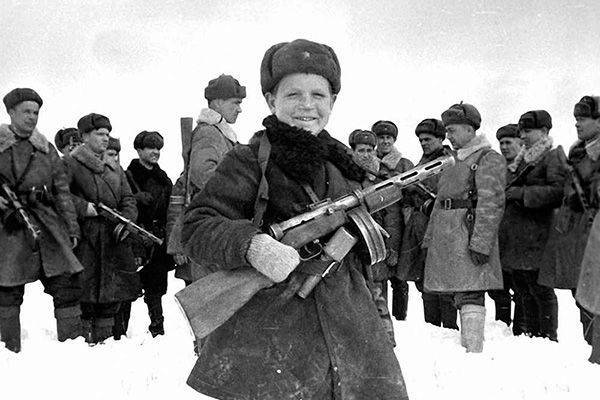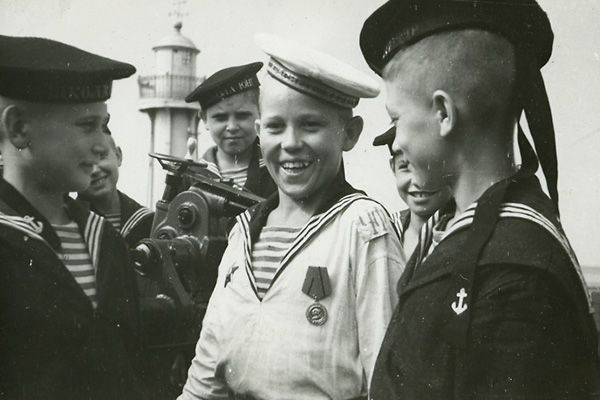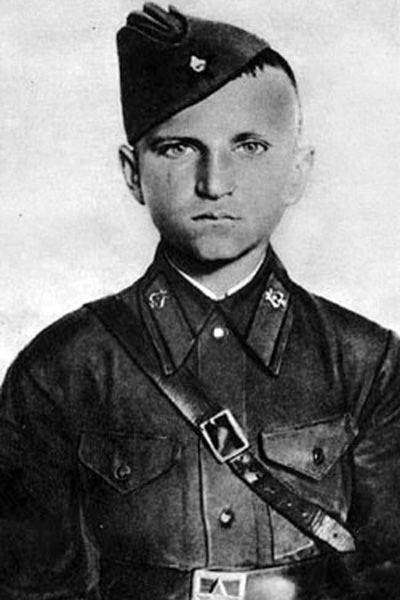Young heroes of the Great Patriotic War and their exploits

Twelve of several thousand examples of unparalleled children's courage
Young heroes of World War II - how many were there? If you count - what else? - the hero of every boy and every girl whom fate brought to the war and made them soldiers, sailors or partisans, then dozens, if not hundreds of thousands.
According to the official data of the Central Archive of the Ministry of Defense (TsAMO) of Russia, during the war years there were more than 3500 military personnel under the age of 16 in military units. At the same time, it is clear that not every commander of the subunit, who dared to take up the regiment’s son, found the courage to declare the pupil on command. To understand how their fathers, the commanders, who really were many instead of fathers, tried to hide the age of the little fighters, it is possible by confusion in award documents. On the yellowed archive sheets, the majority of underage military personnel indicated a clearly overestimated age. The real turned out much later, after ten, or even forty years.
But there were still children and teenagers who fought in partisan detachments and were members of underground organizations! And there they were much more: sometimes partisans left their families, and if not, almost every teenager who found himself in the occupied land had someone to take revenge for.
So "tens of thousands" is far from exaggeration, but rather an understatement. And, apparently, we will never know the exact number of young heroes of World War II. But this is no reason not to remember them.
Boys walked from Brest to Berlin
The youngest of all known little soldiers - in any case, according to the documents kept in military archives - can be considered a pupil of the 142 Guards Rifle Regiment of the 47 Guards Rifle Division Sergey Aleshkin. In the archival documents you can find two certificates of awarding the boy, who was born in 1936 and found himself in the army from September 8 and 1942, shortly after the punishers shot his mother and older brother for his relationship with the partisans. The first document from 26 on April 1943 of the year was about awarding him with the medal “For Military Merit” due to the fact that “Comrade. Aleshkin, the regiment's favorite ”,“ in his cheerfulness, love for the unit and those around him, in extremely difficult moments, inspired cheerfulness and confidence in victory ”. The second, from 19 in November 1945, on awarding pupils of the Tula Suvorov Military School with the medal “For the victory over Germany in World War II 1941 – 1945”: in the list of 13 Suvorov students Aleshkin's name is first.
But still, such a young soldier is an exception, even for wartime and for a country where all the people rose to the defense of the Motherland, from young to old. Most of the young heroes who fought on the front and in the rear of the enemy were, on average, 13 – 14 years old. The earliest of them were defenders of the Brest Fortress, and one of the regiment's sons was a holder of the Order of the Red Star, the Order of Glory of the III degree and the medal “For Courage” Vladimir Tarnovsky, who served in the 370 artillery regiment of the 230 th rifle division, left his autograph the wall of the Reichstag in victorious May 1945 th ...
The youngest Heroes of the Soviet Union
These four names - Lenya Golikov, Marat Kazei, Zina Portnova and Vale Kotyk - for more than half a century have been the most famous symbol of the heroism of the young defenders of our Motherland. Those who fought in different places and performed feats of various kinds according to circumstances were all partisans and all were posthumously awarded the highest award of the country — the title of Hero of the Soviet Union. Two - Lena Golikova and Zina Portnova - by the time they had unprecedented courage, turned out to be 17 years old, two more - Vale Kotik and Marat Casey - only 14.
Lyonya Golikov was the first of the four who received the highest rank: the decree on awarding was signed on 2 on April 1944. The text says that Golikov was awarded the title of Hero of the Soviet Union "for the exemplary performance of command assignments and for showing courage and heroism in battles." Indeed, in less than a year - from March 1942-th to January 1943-th - Lenya Golikov managed to take part in the defeat of three enemy garrisons, in undermining a dozen bridges, in capturing the German major-general with secret documents ... And heroically die in battle near the village of Ostraka Luka, without waiting for the high reward for the seizure of the strategically important "language".
Zina Portnova and Vale Kotiku the titles of Heroes of the Soviet Union were awarded 13 years after the Victory, in 1958 year. Zina was honored for the courage with which she did the underground work, then performed the liaison duties between the partisans and the underground, and eventually endured inhuman torments, falling into the hands of the Hitlerites at the very beginning of 1944. Valya - according to the totality of exploits in the ranks of the Shepetovsk partisan detachment named after Karmelyuk, where he came after a year of work in an underground organization in Shepetovka itself. And Marat Kazei received the highest award only in the year of the 20 anniversary of the Victory: a decree awarding him the title of Hero of the Soviet Union was promulgated on May 8 of the year 1965. For almost two years - from November 1942-th to May 1944-th - Marat fought as part of guerrilla units of Belarus and died, having blown up the last grenade and himself, and the Nazis who surrounded him.
Over the past half century, the circumstances of the exploits of the four heroes have become known to the whole country: by their example, more than one generation of Soviet schoolchildren has grown up, and the current one will certainly tell about them. But among those who did not receive the highest award, there were many real heroes - pilots, sailors, snipers, scouts and even musicians.
Sniper Vasily Kurka
The war caught Vasya a sixteen year old teenager. In the first days he was mobilized on the labor front, and in October he achieved enrollment in the 726 rifle regiment of the 395 th rifle division. At first, the irreducible age of the boy, who also looked a couple of years younger than his age, was left in the wagon train: they say there is nothing for adolescents to do on the front line. But soon the guy got his way and was transferred to a combat unit - a team of snipers.

Amazing military fate: from the first to the last day, Vasya Kurka fought in the same regiment of the same division! Made a good military career, rising to the rank of lieutenant and taking command of a rifle platoon. Recorded at his own expense, according to various sources, from 179 to 200 destroyed by the Nazis. Passed with fights from Donbass to Tuapse and back, and then on, to the West, to the Sandomierz bridgehead. There Lieutenant Kurka was mortally wounded in January of 1945, less than six months before the Victory.
Pilot Arkady Kamanin
5-year-old Arkady Kamanin arrived at the location of the 15 Guards Ground Attack Air Corps along with his father, who was appointed commander of this illustrious unit. The pilots were surprised to learn that the son of the legendary pilot, one of the seven first Heroes of the Soviet Union, a member of the Chelyuskin rescue expedition, will work as an aviation mechanic in a communications squadron. But soon they became convinced that the “general’s son” did not at all justify their negative expectations. The boy was not hiding behind the back of the famous father, but simply did his job well - and he strove with all his might to the sky.

Soon, Arkady got his way: first, he rises into the air as a Letnab, then as a navigator on the U-2, and then goes on the first independent departure. And finally - the long-awaited appointment: the son of General Kamanin becomes the pilot of the 423-th separate communication squadron. Before victory, Arkady, who had reached the rank of foreman, managed to fly almost 300 hours and earn three orders: two - the Red Star and one - the Red Banner. And if it wasn't for the meningitis, literally in a matter of days, he killed the 18-year-old guy in the spring of 1947, perhaps in the cosmonaut detachment, the first commander of which was Kamanin Sr., would have been counted as Kamanin Junior: Arkady managed to enter the Zhukovsky Air Force Academy back in 1946 year.
Front Scout Yuri Zhdanko
In the army, ten-year-old Yura turned out to be an accident. In July, 1941 of the year went to show to the retreating Red Army soldiers a little-known ford on Zapadnaya Dvina and did not have time to return to their native Vitebsk, where the Germans had already entered. So he went along with the part to the east, all the way to Moscow, in order to begin the journey back to the west from there.

On this path Yura had a lot. In January, 1942, he, who had never jumped with a parachute before, went to the rescue of the partisans who were surrounded and helped them break through the enemy ring. In the summer of 1942, together with a group of reconnaissance colleagues, it blows up a strategically important bridge across the Berezina, sending not only the bridge bed to the bottom of the river, but also nine trucks passing through it, and less than a year later it turned out to be the only one of all messengers who managed to break through to the surrounded battalion and help him out of the "ring".
By February, the 1944 th chest 13-year scout decorated the medal "For Courage" and the Order of the Red Star. But a shell that exploded literally underfoot interrupted Jura's frontline career. He went to the hospital, from where he went to the Suvorov School, but did not pass for health reasons. Then the retired young intelligence officer retrained as welders and on this “front” also managed to become famous, having traveled almost half of Eurasia with his welding machine - he built pipelines.
Infantryman Anatoly Komar
Among the 263 of the Soviet soldiers, who closed the enemy embrasures with their bodies, the youngest was the 15-year-old ordinary 332 reconnaissance company of the 252 rifle division of the 53-th army of the 2-th Ukrainian Front Anatoly Komar. The teenager got into the army in September of 1943, when the front came close to his native Slavyansk. This happened to him almost the same as that of Yura Zhdanko, with the only difference that the boy served as a guide not for the retreating, but for the advancing Red Army men. Anatoly helped them to go deep into the front line of the Germans, and then went along with the advancing army to the west.

But, unlike Yura Zhdanko, Toli Komar’s front-line path was much shorter. Only two months he had the opportunity to wear epaulettes that had recently appeared in the Red Army and go on reconnaissance. In November of the same year, returning from a free search in the rear of the Germans, a group of intelligence officers revealed themselves and had to break through to their own with a fight. The last obstacle on the way back was the machine gun that pressed the reconnaissance to the ground. Anatoly Komar threw a grenade at him, and the fire died down, but as soon as the scouts got up, the machine gunner started shooting again. And then Tolya, who was closest to the enemy, rose and fell on a machine-gun barrel, at the cost of living, buying comrades precious moments for a breakthrough.
Sailor Boris Kuleshin
On a cracked photo on the background of sailors in black uniform with cartridge boxes on the back and superstructures of the Soviet cruiser is a boy of ten. His hands tightly tighten the machine PPSH, and on his head there is a cap with a guards tape and the inscription "Tashkent". This is a graduate of the crew of the leader of the Tashkent destroyers Borya Kuleshin. The picture was taken in Poti, where after repair the ship went for another load of ammunition for the besieged Sevastopol. It was here that twelve-year-old Boria Kuleshin appeared at the “Tashkent” gangway. His father died at the front, his mother, as soon as Donetsk was occupied, was ousted to Germany, and he managed to leave across the front line to his own and with the retreating army to get to the Caucasus.

While persuading the ship's commander Vasily Eroshenko, while making a decision about which war unit to enlist as a young man, the sailors managed to give him a belt, visor and assault rifle and photograph a new crew member. And then there was a transition to Sevastopol, the first in the life of Bori raid on “Tashkent” and the first in the life of clips for anti-aircraft artillery, which he, along with other anti-aircraft gunners, gave the shooters. In his combat post, he was wounded on July 2, 1942, when the German aviation tried to sink a ship in the port of Novorossiysk. After the hospital, Borya, following captain Eroshenko, came on a new ship - the guards cruiser "Red Caucasus". And already here he earned a well-deserved award: presented for the battles at “Tashkent” for the medal “For Courage”, he was awarded the Order of the Red Banner by the decision of the front commander Marshal Budyonny and member of the Military Council Admiral Isakov. And in the next front-line shot, he already flaunts in a new uniform of a young sailor, who has a visor on his head with a visor with a guards ribbon and the inscription "Red Caucasus". It was in this form that in 1944 Borya went to the Tbilisi Nakhimov School, where in September 1945 he was among the other teachers, educators and pupils awarded the medal "For the victory over Germany in the Great Patriotic War of 1941-1945."
Musician Peter Klypa
Fifteen-year-old pupil of the music platoon of the 333 Infantry Regiment Peter Klypa was supposed to go to the rear with the start of the war, like other underage inhabitants of the Brest Fortress. But to leave the fighting stronghold, which, among others, was defended by the only native person - his older brother, Lieutenant Nikolai, Petya refused. So he became one of the first in stories World War II teenage soldiers and a full participant in the heroic defense of the Brest Fortress.

He fought there until the beginning of July, until he received an order, along with the remnants of the regiment, to break through to Brest. From here began the ordeals of Petit. Having crossed the tributary of the Bug, he, among other colleagues, was captured, from which he soon managed to escape. I reached Brest, lived there for a month and moved east, behind the retreating Red Army, but did not reach. During one of the overnight stays, he and his friend were found by policemen, and the teenagers were sent to forced labor in Germany. Petya was released only in 1945 year by the American troops, and after checking he even managed to serve for several months in the Soviet army. And when he returned home, he again fell behind bars, because he succumbed to the persuasion of an old friend and helped him to speculate about the loot. Peter Klypa was released only after seven years. He needed to thank for this the historian and writer Sergey Smirnov, who by bit recreated the history of the heroic defense of the Brest Fortress and, of course, did not miss the history of one of its youngest defenders, who after the liberation was awarded the Order of the Patriotic War I degree.
- Sergey Antonov
- http://rusplt.ru/society/yunyie-geroi-velikoy-otechestvennoy-voynyi-i-ih-podvigi-17992.html
Information